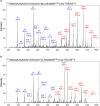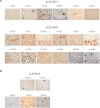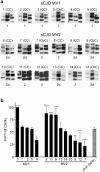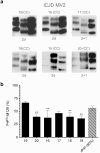The Distribution of Prion Protein Allotypes Differs Between Sporadic and Iatrogenic Creutzfeldt-Jakob Disease Patients
- PMID: 26840342
- PMCID: PMC4740439
- DOI: 10.1371/journal.ppat.1005416
The Distribution of Prion Protein Allotypes Differs Between Sporadic and Iatrogenic Creutzfeldt-Jakob Disease Patients
Erratum in
-
Correction: The Distribution of Prion Protein Allotypes Differs Between Sporadic and Iatrogenic Creutzfeldt-Jakob Disease Patients.PLoS Pathog. 2016 Mar 8;12(3):e1005496. doi: 10.1371/journal.ppat.1005496. eCollection 2016 Mar. PLoS Pathog. 2016. PMID: 26954665 Free PMC article. No abstract available.
Abstract
Sporadic Creutzfeldt-Jakob disease (sCJD) is the most prevalent of the human prion diseases, which are fatal and transmissible neurodegenerative diseases caused by the infectious prion protein (PrP(Sc)). The origin of sCJD is unknown, although the initiating event is thought to be the stochastic misfolding of endogenous prion protein (PrP(C)) into infectious PrP(Sc). By contrast, human growth hormone-associated cases of iatrogenic CJD (iCJD) in the United Kingdom (UK) are associated with exposure to an exogenous source of PrP(Sc). In both forms of CJD, heterozygosity at residue 129 for methionine (M) or valine (V) in the prion protein gene may affect disease phenotype, onset and progression. However, the relative contribution of each PrP(C) allotype to PrP(Sc) in heterozygous cases of CJD is unknown. Using mass spectrometry, we determined that the relative abundance of PrP(Sc) with M or V at residue 129 in brain specimens from MV cases of sCJD was highly variable. This result is consistent with PrP(C) containing an M or V at residue 129 having a similar propensity to misfold into PrP(Sc) thus causing sCJD. By contrast, PrP(Sc) with V at residue 129 predominated in the majority of the UK human growth hormone associated iCJD cases, consistent with exposure to infectious PrP(Sc) containing V at residue 129. In both types of CJD, the PrP(Sc) allotype ratio had no correlation with CJD type, age at clinical onset, or disease duration. Therefore, factors other than PrP(Sc) allotype abundance must influence the clinical progression and phenotype of heterozygous cases of CJD.
Conflict of interest statement
The authors have declared that no competing interests exist.
Figures






Similar articles
-
Transmission characteristics of heterozygous cases of Creutzfeldt-Jakob disease with variable abnormal prion protein allotypes.Acta Neuropathol Commun. 2020 Jun 9;8(1):83. doi: 10.1186/s40478-020-00958-x. Acta Neuropathol Commun. 2020. PMID: 32517816 Free PMC article.
-
Association of prion protein genotype and scrapie prion protein type with cellular prion protein charge isoform profiles in cerebrospinal fluid of humans with sporadic or familial prion diseases.Neurobiol Aging. 2014 May;35(5):1177-88. doi: 10.1016/j.neurobiolaging.2013.11.010. Epub 2013 Nov 16. Neurobiol Aging. 2014. PMID: 24360565
-
Creutzfeldt-Jakob disease (CJD) with a mutation at codon 148 of prion protein gene: relationship with sporadic CJD.Am J Pathol. 2005 Dec;167(6):1729-38. doi: 10.1016/S0002-9440(10)61254-0. Am J Pathol. 2005. PMID: 16314483 Free PMC article.
-
Neuropathological and biochemical criteria to identify acquired Creutzfeldt-Jakob disease among presumed sporadic cases.Neuropathology. 2016 Jun;36(3):305-10. doi: 10.1111/neup.12270. Epub 2015 Dec 15. Neuropathology. 2016. PMID: 26669818 Review.
-
Virus Infection, Genetic Mutations, and Prion Infection in Prion Protein Conversion.Int J Mol Sci. 2021 Nov 18;22(22):12439. doi: 10.3390/ijms222212439. Int J Mol Sci. 2021. PMID: 34830321 Free PMC article. Review.
Cited by
-
Chronic wasting disease (CWD) prion strains evolve via adaptive diversification of conformers in hosts expressing prion protein polymorphisms.J Biol Chem. 2020 Apr 10;295(15):4985-5001. doi: 10.1074/jbc.RA120.012546. Epub 2020 Feb 28. J Biol Chem. 2020. PMID: 32111742 Free PMC article.
-
Interventions to reduce the risk of surgically transmitted Creutzfeldt-Jakob disease: a cost-effective modelling review.Health Technol Assess. 2020 Feb;24(11):1-150. doi: 10.3310/hta24110. Health Technol Assess. 2020. PMID: 32122460 Free PMC article.
-
Domain-specific Quantification of Prion Protein in Cerebrospinal Fluid by Targeted Mass Spectrometry.Mol Cell Proteomics. 2019 Dec;18(12):2388-2400. doi: 10.1074/mcp.RA119.001702. Epub 2019 Sep 26. Mol Cell Proteomics. 2019. PMID: 31558565 Free PMC article.
-
A novel mechanism of phenotypic heterogeneity in Creutzfeldt-Jakob disease.Acta Neuropathol Commun. 2020 Jun 19;8(1):85. doi: 10.1186/s40478-020-00966-x. Acta Neuropathol Commun. 2020. PMID: 32560672 Free PMC article.
-
Prion protein polymorphisms associated with reduced CWD susceptibility limit peripheral PrPCWD deposition in orally infected white-tailed deer.BMC Vet Res. 2019 Feb 4;15(1):50. doi: 10.1186/s12917-019-1794-z. BMC Vet Res. 2019. PMID: 30717795 Free PMC article.
References
-
- Parchi P, Saverioni D. Molecular pathology, classification, and diagnosis of sporadic human prion disease variants. Folia Neuropathol. 2012;50: 20–45. - PubMed
Publication types
MeSH terms
Substances
Supplementary concepts
Grants and funding
LinkOut - more resources
Full Text Sources
Other Literature Sources
Medical
Research Materials

